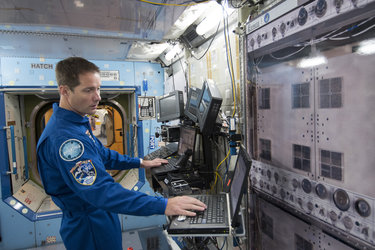Core lessons
There are a number of pre-requisites before astronauts are admitted to ATV training. These include experience with the Russian Docking System (RDS), which is needed because the ATV will dock to the Russian Service Module Zvezda; and also experience with the American Inventory Management System (IMS), a barcode reader system similar to that used in supermarkets, which helps the astronauts find items on the Station and to keep it tidy.
Using the reader the astronauts scan the cargo 'out' of its location inside ATV and 'in' to the new location where it will be stored in the ISS. In this way, a computer can track the inventory on board the ISS and the astronauts do not have to memorize the whereabouts of every single item.
This system is invaluable since there is a full crew rotation about every six months. Imagine moving into someone else's house and trying to find a pair of scissors – only it is even more difficult in the Station since there is not such a clear boundary between the kitchen and the work area, for example.

Prepared with this knowledge, ATV trainees start off with classroom lessons, which give them a general overview of what the ATV is, how it works and what happens during an ATV mission. This is followed by a first tour through the ATV mock-up. Here the astronauts can put into practice what they learned in class – an approach that returns throughout the training.
Before the astronauts can proceed to the 'real action' – such as how to dock ATV to the ISS, and how to supervise cargo transfer to the ISS – there is more classroom work to be done. The trainees attend lessons on the ATV's systems and its navigation sensors. These conclude the 'core lessons' – the basics about the ATV spacecraft and how it works.















 Germany
Germany
 Austria
Austria
 Belgium
Belgium
 Denmark
Denmark
 Spain
Spain
 Estonia
Estonia
 Finland
Finland
 France
France
 Greece
Greece
 Hungary
Hungary
 Ireland
Ireland
 Italy
Italy
 Luxembourg
Luxembourg
 Norway
Norway
 The Netherlands
The Netherlands
 Poland
Poland
 Portugal
Portugal
 Czechia
Czechia
 Romania
Romania
 United Kingdom
United Kingdom
 Slovenia
Slovenia
 Sweden
Sweden
 Switzerland
Switzerland

































